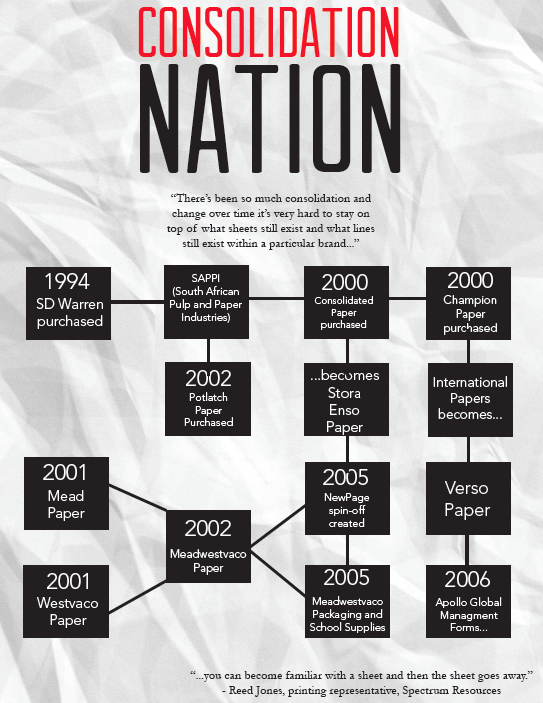The smell of sulfur is never easy to stomach. Eggy and pungent. Anyone who has been around a paper mill is all too familiar.
Every morning, at the figurative crack of dawn, the smell wafts across northeastern Wisconsin from Neenah to Menasha then upwards on to Appleton and Combined Locks, the aptly named “Paper Valley.”
But this morning in Kimberly, the air is crisp. So fresh it’s almost harsh, nose hairs standing straight, grasping for every ounce of purity. For most, this is a beautiful thing, a sign of life. For the 600 some odd workers who used to wake up to the smell of sulfur at the NewPage Paper Mill in Kimberly, it’s the opposite.
The NewPage mill was pieced, parted and leveled in March 2012.
“If you were to go look at the NewPage mill, all you would see is a construction fence with mountains of rubble behind it and a water tower,” Ferko Goldinger, marketing manager at Appleton Coated Paper, says. “There are physical reminders all over the area.”
NewPage isn’t alone, as buyouts and consolidation have put families out of work across Wisconsin paper mills over the last decade.
“It’s kind of the perfect storm … for those kinds of communities,” says Reed Jones, a printing consultant at Spectrum Resources who has worked in the commercial printing industry for nearly 30 years. “It all works so well until there’s nothing there. It’s not like these people are warned. All of the sudden work is there one generation and completely gone halfway through the next.”
Wisconsin and her industry were fundamentally shaped by those people, by those generations, by paper. For decades, the Wisconsin paper industry led the country in paper production and profit margin. Until now.
Amid pushes toward new technology, pleas to use less paper and foreign competition, many rightfully question what will become of paper. Moreover, they ask what will become of the industry that has played such a huge part in shaping the state of Wisconsin.
On the surface, and the leveled surfaces of mills, the picture is grim.
But for many behind the scenes and in the know, this is a story — not yet finished — of an industry fighting misconceptions to show that it may just have a future in a digital world.
But to understand the future of paper in Wisconsin, it is paramount to know its past.
PAPER’S PAST
Paper production rose to monumental status in the state because, sometimes, a state doesn’t have to work very hard to find its leading industry. In fact, most of the time, industry is a product of the best the state naturally has to offer. With a heavily forested landscape from north to south, lined with rivers like arteries for carrying timber, this state was made to move wood.
“Wood products are core to Wisconsin’s industrial base, and paper is certainly a very significant part of that on a dotted line basis,” Goldinger says. “It’s a very manufacturing-centered state with great workforce.”
In the seven years after the state’s second paper mill opened in Appleton in 1853, Wisconsin was already producing the most paper of any Midwestern state, with an annual output of nearly 1.7 million pounds. The introduction of railroad lines to the Northwoods allowed trees to move to the Fox Valley area for processing even faster, making the greater Green Bay area the undisputed national hub for paper. As consumer culture flourished and demand rose for paper products like paper towel and tissue in the early 20th century, the state responded, shifting its focus from newsprint to consumer goods and advancing printing techniques. In 1967, Wisconsin was employing an industry peak of over 21,000 people.
Times have changed since 1967.
CONSOLIDATION NATION
Looking back to the NewPage mill, massive beams and wells and machinery that were once undoubtedly integral to making paper now sit dusty and idle, reduced to mere garbage. Signs that warn “CAUTION: MOVING MACHINERY” still stand in grim irony.
Consolidation has swept through and hit hard.
“You have some huge conglomerate come in and purchase and consolidate and decide rather than keep this mill open, with perhaps its unionized labor force, let’s shut the mill down and just replace that particular line of paper with some foreign sheet that we also represent,” Jones says.
Although this trend hits mill workers hardest and most directly, the effects ripple through every link in the supply chain.
“It’s very hard to stay on top of where the industry is at because there has been so much change. You can become familiar with a sheet and then the sheet goes away,” Jones says. “If it’s affecting people like me who work with printers a lot then imagine what it does with creatives where it’s even harder to stay current.”
Consolidation, buyouts and shutdowns have made for tidal shifts in not just the physical and economic nature of the paper industry, but also the lifestyle and culture throughout the Fox Valley area.
“It cuts across hourly, salaried. It hits the village’s tax base and income base. There are huge ripples,” Goldinger says. “Think of all the people that are not going out to eat, not buying lunch, all the rest.”
Consolidation’s effects are clear. However, consolidation is the endgame in a process that begins with threats from digital technologies and foreign competition.
THE SUSPECTS
In a society that is increasingly digital, paper has little part. At least that’s what the skeptics say.
No doubt, making our lives more digital has its upsides. It also has had – and will continue to have – a dramatic, measurable effect on paper for print. However, paper is use for more than just printing paper.
“Everyone needs to recognize that the paper industry isn’t simply 8½-by-11 copy paper,” Jeff Landin, president of the Wisconsin Paper Council, says in his article, “Paper Industry still Strong in Wisconsin.” “Think medical supplies. Microwave popcorn bags. Food packaging. Receipts at gas pumps and restaurants. Lottery tickets. Beer and wine labels. Toilet tissue, paper towels and napkins. Cardboard boxes. Gift-wrapping paper.”
While books and notebooks may have met their demise in the Kindle and the like, paper still has a fighting chance.
“Where you see less paper being used is from the publishing industry,” Jones says. “The publishing industry is what’s dying.”
“If we don’t buy the book, we’re still buying the Kindle and the Kindle is still coming in packaging and that is probably getting mailed to us in more packaging,” Tom Eggert, senior lecturer at the UW-Madison School of Business and executive director of the Wisconsin Sustainable Business Council, says.
Moreover, those who do actually make an all-digital switch are most likely interacting with paper without even knowing it. “There’s all kinds of papers that you don’t even know. The paper that’s actually inside that is the label of a Tide bottle that you would swear is plastic is actually paper,” Goldinger says.
“The data that suggests we are using less paper is dead wrong. I just don’t think there is credible data that says we’re using less paper,” Eggert echoes.
The next major and perhaps more real threat is foreign markets providing paper products at a significantly lower price. Indeed, imports have always been a threat to North American papermaking. The newest wave of competition, however, is perhaps crashing harder than any before.
Due to heavy government subsidies and financial backing, extremely low operational and production costs and the fact that they lead the world in products made, packaged and shipped, Asian markets more specifically China have taken a majority market share in global paper production. Those are the facts. However, these facts are about economics. Certainly, economic trends can sway.
“I predict that energy prices are going to continue to go up … As we have more and more people from India and China entering the middle class and creating higher expectations and more demands on our energy systems, there’s more users, there’s more customers and at best we have a fixed supply. So if you’ve got more demand and a fixed supply, your prices are going to go up over time,” Eggert says.
What energy has to do with paper of the foreign variety is all about the way we import it.
“What works in paper’s favor is that paper’s pretty heavy. So if energy prices go up and you’re having to bring paper across the ocean from either China or South America, those costs could go up enough so that it would justify what they call ‘onshoring’ or ‘reshoring’ jobs in this country,” Eggert says.
A NEW HOPE
To better appreciate paper’s future, it would again be a disservice not to correct a key myth about paper itself: that it’s not sustainable. There seems to be a push to print less, buy less and carry less in paper. In fact, it is proven time and time again that paper is a recyclable industry.
“All of the documents that we print at work these days are all printed on 100 percent post-consumer recycled paper,” Eggert says. “Which means this is paper from the offices around the state that is re-gathered, recycled, repulped, and new paper is created out of paper that has already been used once.”
Also, trees for paper production are essentially a crop. They are grown and regenerated as such and have been for centuries. Nearly every mill in the country is working with groups like the Forest Stewardship Council to document their production process from standing tree to final sheet.
“To have that kind of linkage between groups that were formally enemies speaks to how much change has occurred in the industry and how deeply vested the forest products industry is in being sustainable,” Goldinger says.
“They’re farming it like a crop,” Jones says. “They own so much timberland and so many acres in a lot of these communities that they’ve got a harvestable crop going at all times … They have managed this for years.”
On a related note, it may be a disservice to digital in giving it endless praise. Between the new must-have smartphone that comes out every month and the planned redundancy of withheld features, paper may in fact be just as environmentally friendly as digital tools.
“You look at the environmental footprint of a new phone or a new computer, and it’s substantial,” Eggert says. “We’re going to need to find some more sustainable ways of providing that technology.”
Another hidden and potential problem in the paper industry is the fact that its workforce is aging rapidly as is true with many old American industries. However, this too may open new doors moving forward.
“I think there’s opportunities for students … in terms of servicing the paper industry and bringing the kind of thinking that has been traditionally applied to startups and dot coms over into the paper industry,” Goldinger says.
“The students I’m sending into the world when you survey them as to what they’re looking for in an employer, it is not the biggest salary or the largest paycheck any longer,” Eggert says. “They want to work with an organization that has a value set that resonates with them, that they believe in and where they feel they’re going to make a difference.”
THE FUTURE
That is where things are today.
Where will paper be when the dust settles? Are we always going to have paper and a need for paper? Eggert, Jones and Goldinger unanimously say yes.
It appears that paper does indeed have more than a fighting chance. Generally, it appears that the longstanding American industry may stand longer. In the same sense that the American automotive industry has shown fight, it seems that, despite leveled and consolidated mills that the tide may be turning. Specifically, though, the jury is still out on its future in Wisconsin.
What is the future of other towns like Kimberly? Will the air go from pungent to pure for the worse? “Paper in Wisconsin?” questioned Eggert. “There’s a lot of questions about what the future is going to be.”
The beauty, perhaps, of an old industry is that it has had to prove itself as strong and durable time and time again. What lies ahead may be unknown but what lies in the past – even if it’s no longer standing – is promising.





